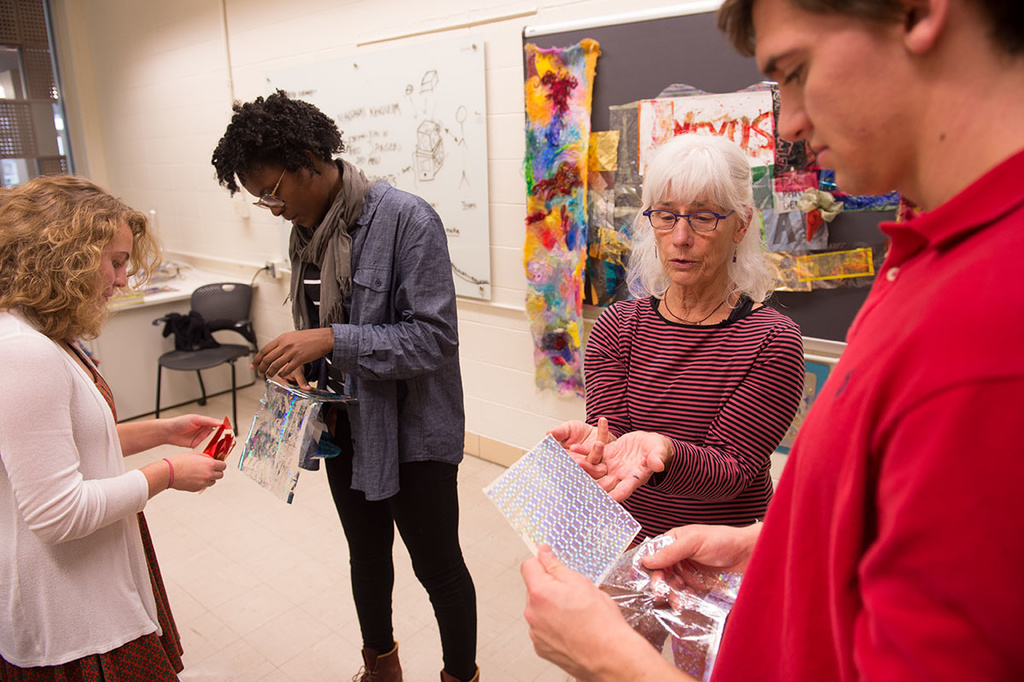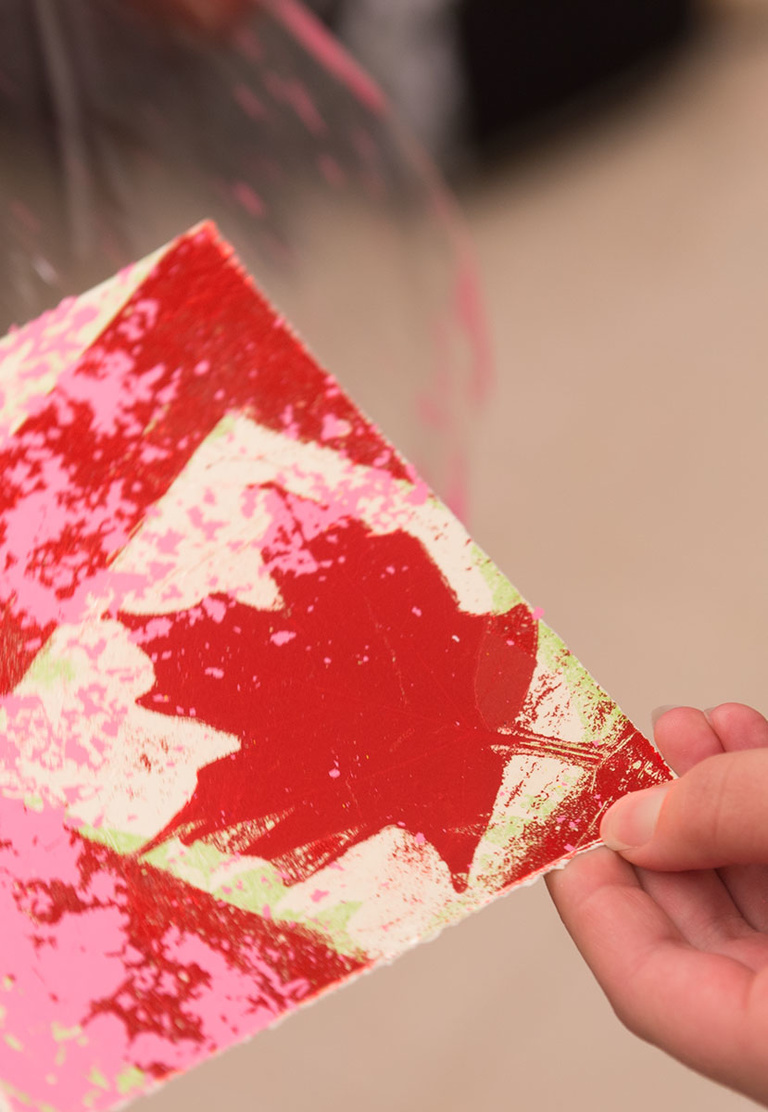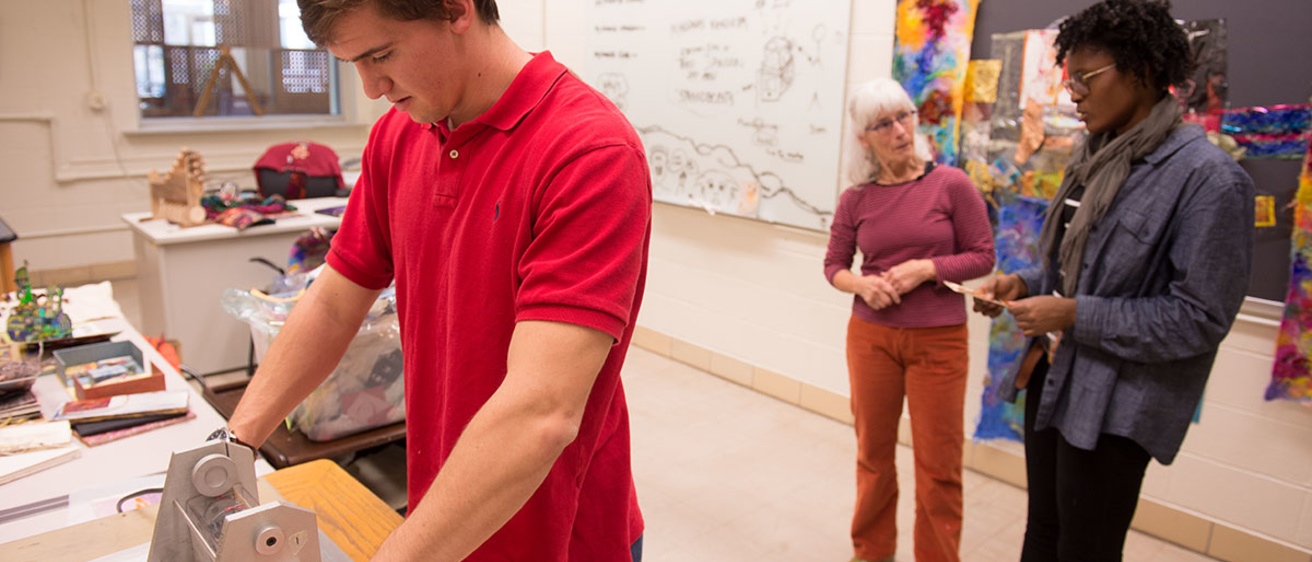Until August, Deanne Wortman had never organized her life on a planning calendar.
That’s when the printmaker and adjunct professor was hired to lead the University of Iowa College of Engineering’s new Nexus of Engineering and Art program, one that puts the college at the forefront of a national trend to encourage interaction between students and faculty from both disciplines.
Now, Wortman often finds her schedule overbooked. But, she says, it’s wildly exciting to be part of an idea that’s new to college campuses.
Melding engineering and art is the way great thinkers have always worked, Wortman says.
“What if Michelangelo and da Vinci had only thought of themselves as painters and nothing else?” she says. “What if Charles Ives had thought of himself as only a businessman and not also a musician? We’d all be the poorer for it, culturally. I think those dividing lines are not useful.”
The UI College of Engineering is forging into uncharted territory with its commitment to include the arts as a component of its undergraduate education. In May 2015, college faculty approved a general education requirement that all new undergraduate students take at least three semester hours in the creative arts.
"What if Michelangelo and da Vinci had only thought of themselves as painters and nothing else? What if Charles Ives had thought of himself as only a businessman and not also a musician? We’d all be the poorer for it, culturally. I think those dividing lines are not useful."
—Deanne Wortman
The college is also creating a Project Design Studio, a unique, hands-on “maker” classroom unlike any other on campus. It’s part of a $37 million addition to accommodate growing enrollment. Ground breaking is scheduled for early next year.
Alec Scranton, dean of the College of Engineering, said he was inspired to make his idea for Nexus a reality after realizing how meaningful it could be to students.
“The importance of the connection between engineering and the arts is becoming more widely appreciated,” he says. “We’re a fantastic place for this kind of interaction to develop and thrive because of the tremendous arts and humanities that exist on campus.”
The Virginia A. Myers Nexus of Engineering and Art program strives to build partnerships and foster relationships with artists and art faculty with the goal of creating collaborative opportunities among engineering and art students and faculty, according to the college, whose motto is "Engineering...and something more."
The Nexus program is part of that something more, says Associate Dean for Academic Programs Keri Hornbuckle, who also sits on the campuswide Arts Advancement Committee. Exposure to the arts is important because the college’s curriculum evolves to meet the needs of its students.
“The expectations of engineers have changed,” Hornbuckle says. “Engineers are now leaders in our culture. Engineers are seen as people who bring positive change. Engineers are recognized as providing solutions across disciplines. We are not just the people designing the motors anymore.”
She says inclusion and immersion in the arts has been met with enthusiasm by both students and faculty.

“Our faculty can see the opportunity and that’s not always true in bigger, less-flexible engineering programs,” she says. “Tradition can be so hard-wired that it can be difficult for people to see another way. But our faculty aren’t like that. We’re used to changing directions and identifying new areas, and we’re not stuck in old traditions. You can see that in the number of women and under-represented minorities in our college. Our incoming class this fall was 29 percent women; that’s way higher than the national average. So we’re used to welcoming difference.”
Alan MacVey, co-chair of the Campuswide Committee, chair of the Department of Theatre Arts, and director of the Division of Performing Arts, says the College of Engineering is doing what most other institutes of higher education are only talking about.
“It’s an unusual thing, certainly in Iowa,” MacVey says. “There’s a new recognition that the arts aren’t just things you go see, but actually are very useful to students in all kinds of disciplines. There’s a lot of talk about how important incorporating them is and how challenging it is.
“It’s one thing to talk about it. It’s another thing to actually do it. It’s brave and forward-looking of the engineering faculty,” he says. “We in the arts are very happy about it.”
Wortman is full of ideas and exudes enthusiasm. She sees only opportunity in a program that has few defined lines—very much in keeping with her curious nature.
While a key part of her job will be helping students learn how to use the Iowa Foil Printer (IFP), a machine invented by program namesake Myers when she was a professor at the UI, Wortman sees opportunity for jam sessions, improv, crocheting and knitting, creative writing, ceramics, and much more.

On Nov. 5, she will take part in a roundtable discussion in Des Moines called "Creativity Connects," sponsored by the National Endowment for the Arts and the Iowa Arts Council. This discussion will help develop an NEA roadmap for how the arts can connect with other sectors that utilize creativity.
Sunil Iyengar, research and analysis director for the NEA, said the arts are an “inevitable bedfellow with engineering.” Research has shown, he says, that involving students in the arts as the College of Engineering is doing gives them a broader base from which to learn.
“The arts can engage people in the sciences perhaps more effectively than science alone. That’s a key part,” he says.
And, Wortman says, she hopes to engage students in a way that makes them even more excited about their field of study.
“In all of this, I have never seen the dividing lines that everyone sees between disciplines,” Wortman said. “Piranesi, da Vinci, Michelangelo—they were all engineers and artists. It was not such a big division back then, so a lot of these guys built buildings and made pictures all at the same time. We need to not see dividing lines. I think we need to see opportunities to come together.”
Who is Virginia A. Myers?
Virginia A. Myers is a professor emerita in the University of Iowa School of Art and Art History and a renowned printmaker. She came to Iowa City in 1955 to study with artist Mauricio Lasansky, who became known as one of the fathers of 20th-century American printmaking.
After studying in Paris on a Fulbright Scholarship from 1961 to 1962, Myers joined the faculty at UI where she taught printmaking.
In 1983, Myers began researching the use of gold leaf and foil in the printmaking process and discovered that foil was strictly commercial and was not being used in the fine arts. Her dissatisfaction with foiling options available to artists led her to invent the Iowa Foil Printer (IFP), a device that allows artists to incorporate foil stamping into their work.
The printer applies heat from both the top, via a printer roller, and bottom, via a hot plate. Using heat and pressure from the roller, foil or roll-leaf can be applied to a variety of mediums, including paper, metal, leather, and plastics. The foil or roll-leaf is adhered to a plastic film and is then transferred to the medium during the printing process. The foil is available in a variety of metallic, pigments, pearlescents, tin foils, and holograms.
Myers and her former students, like Deanne Wortman, continue to develop and perfect hot-stamped foil techniques in original works of art.
Myers lives in Iowa City.
